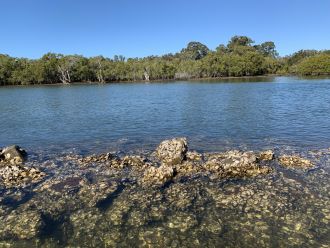News release
From:
New research led by Southern Cross University has found a cocktail of nasty pesticides in oysters and water from one of the NSW North Coast’s dominant rivers.
Samples taken from the Richmond River estuary reveal 21 different pesticides, including a mix of herbicides, insecticides and fungicides. The findings are published in the journal Environmental Pollution. https://doi.org/10.1016/j.envpol.2023.123084
“This study is the most comprehensive investigation that has been undertaken into the pesticides entering our waterways from agricultural and urban run-off in northern NSW,” said senior author Professor Amanda Reichelt-Brushett.
“We actually had to couch this publication in the context of our extremely limited background knowledge of pesticides in the Richmond River.”
The concentrations of several pesticides exceeded safe environmental guidelines, including atrazine and diuron that are banned overseas. Benomyl was also detected despite being banned in Australia.
The researchers found more pesticides in the oysters than in the surrounding water, with an average of nine different pesticides in single oyster samples.
“Oysters accumulate contaminants because they filter large volumes of water when feeding,” said co-author Professor Kirsten Benkendorff.
“Many of these pesticides have no allowable residue limits in seafood, and could be quite risky to humans if consumed. We also don’t yet know the cumulative risk from exposure to multiple pesticides at once.”
The study investigated six sites within the lower estuary of the Richmond River: Emigrant Creek, Fishery Creek, North Creek, two locations at Empire Vale, and south Ballina. The first three sites are sub-catchments with a variety of land uses, including natural vegetation, plant nurseries, cattle grazing, horticulture (eg macadamia nuts, coffee, bananas, avocados, and stone fruit), urban residential and small industries. The other three sites along the eastern side of the Richmond River estuary receive run-off mostly from sugar cane farming. These areas have drains for flood mitigation through the low-lying sugar cane fields.
The Australian Pesticide and Veterinary Medicine Authority (APVMA) regulates the use of individual pesticides. The Australian Water Quality Guidelines provides guidelines for only some pesticides in fresh and marine waters but guidelines specific to estuaries are not available. Furthermore, these guideline values are only relevant to single contaminant exposure rather than exposure to mixtures.
Yet the researchers found mixtures in every sample they tested.
“Some interesting work on mixture exposure is being done in Queensland in catchments of the Great Barrier Reef and we might be able to build upon that for our future work,” said Professor Reichelt-Brushett.
“At present there is little accountability for the downstream impacts from land-based run-off.”
This study highlights the urgent need to manage diffuse source water pollution in the Richmond River. Further research is required to establish the magnitude of pesticide contamination in other estuaries with intensive agriculture and urban development.
Historically the Richmond River estuary was a prime oyster growing and harvest area. The oyster industry shut down in the 1970s due to QX disease outbreaks from poor water quality. Only one oyster lease remains in operation, close to the mouth of the estuary where there is more oceanic exchange.
Multimedia






 Australia; NSW
Australia; NSW


